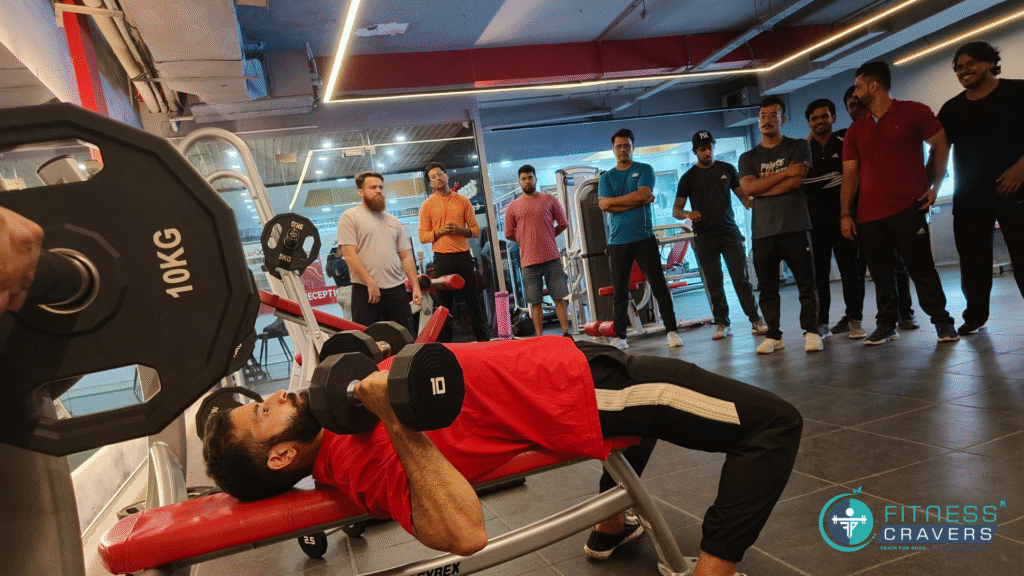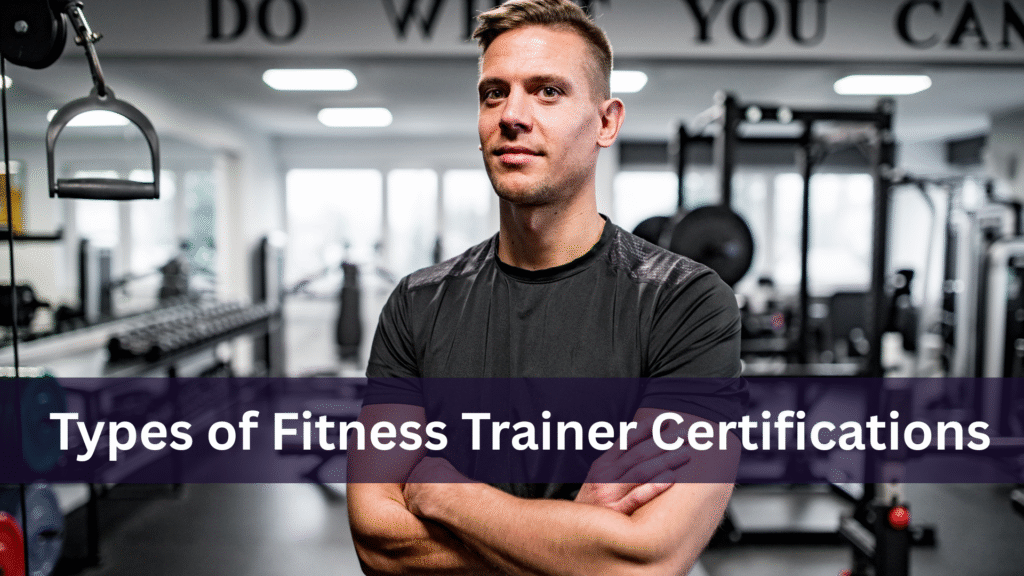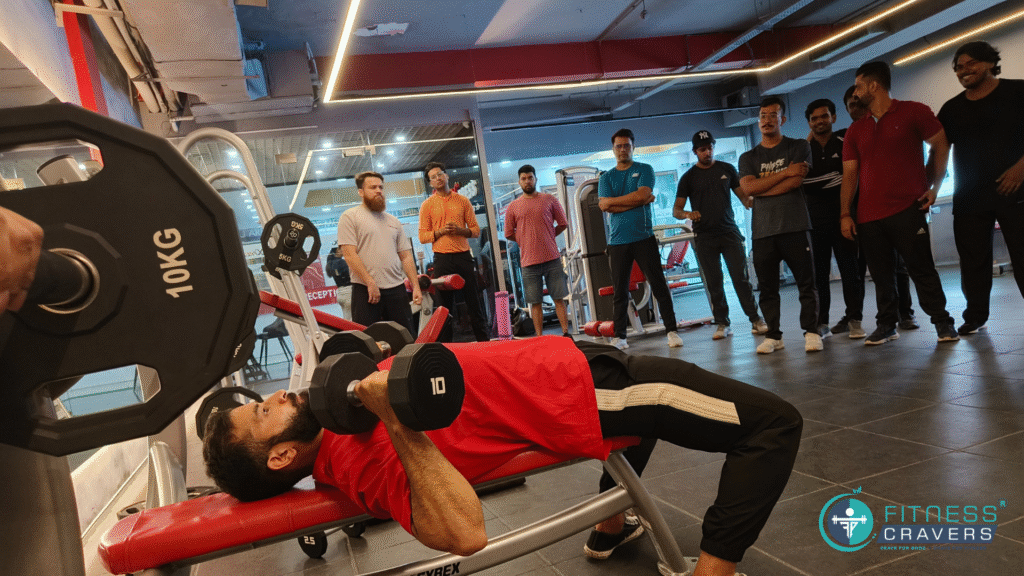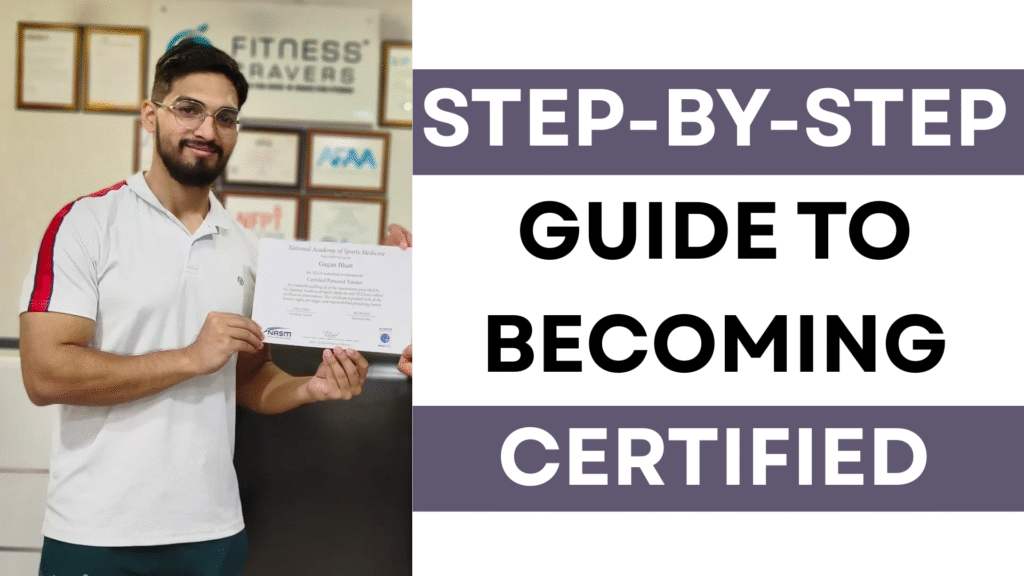Becoming a Fitness Trainer is an exciting and rewarding career. It’s not just about fitness, but about transforming your own life first and then people’s lives to help them lead healthier, more fulfilling lives. However, just like any other career, the journey to success can have its ups and downs. And to set yourself up for long-term success, it’s essential to make the right decisions from the start—beginning with some prestigious certifications needed in Fitness Industry.
In this guide, We will help you navigate the fitness certification landscape, showing you why it’s important, the different types of certifications you can pursue, and how you can start your fitness career on the right foot.
Why Getting Certified as a Fitness Trainer is Important?

Before jumping into the certification process, it’s important to understand why certification matters.
1. Trust and Credibility
Imagine you’re not feeling well. You’d probably go see a doctor, right? Why? Because doctors are trained, trusted professionals with the knowledge and expertise to help you. It’s the same in the fitness world. When clients hire a Personal Trainer, they want to know that the person guiding them has the skills to safely and effectively help them reach their fitness goals. Certification provides that authenticity and credibility. It’s proof that you’ve received the proper training to guide others through their fitness journey safely by studying Human Anatomy, Physiology, Biomechanics, Human Movement Science etc.
2. Professional Growth
Long time back, being a Fitness Trainer didn’t always require formal certifications. But today, certification is important for building a successful career in fitness. Whether you want to work in a gym, wellness center, or start your own personal training business, certification opens doors and establishes you as a professional. After all, it is all about the trust. If you had to entrust your near and dear ones for an example your mother to someone for training, who would you choose? That is why it is essential to be a qualified and experienced Fitness Trainer who prioritizes safety, injury free movements and train with honesty.
3. Increased Earning Potential
Do you know certified trainers generally earn more than non-certified ones. Why? Because certification shows clients that you are qualified to give them the best results, which can justify higher fees. The more knowledge and skills you have, the more value you can provide and that’s worth paying for.
4. Training with Confidence
A certified trainer knows in depth anatomy, kinesiology, human movement science, nutrition and biomechanics, which helps to reduce the risk of injury and ensures that clients are getting the most out of their workouts. This deeper understanding of how the body works means that you’re not just counting reps; you’re guiding clients through efficient, safe, and targeted exercises.
5. Personal Satisfaction
For all of us, Fitness isn’t just a job, it’s a passion. Seeing the positive impact you can have on someone’s life is exceptionally rewarding. Whether it’s helping someone correct their posture, lose weight, improve their mobility, or simply feel more confident, the sense of fulfillment is a lot and getting paid to do something you’re passionate about only adds to that satisfaction.
Types of Fitness Trainer Certifications

There are several different types of certifications you can pursue, depending on your interests and the kind of work you want to do. Let’s break down the most common certifications and providers:
1. Certification in Personal Training (CPT)
This is the most popular certification for those who want to work one on one with clients. As a personal trainer, you’ll design individualized workout plans and provide motivation and guidance to help clients achieve their fitness goals.
Top Certification Providers:
Fitness Cravers Academy (FCA) – Personal Trainer Certification

National Academy of Sports Medicine (NASM)
Professional Development UK with REPS India (PD-UK REPS India)
American Council on Exercise (ACE)
International Sports Sciences Association (ISSA)
Example: Imagine you’re helping an athlete prepare for a marathon. As a certified personal trainer, you’ll be able to create a custom plan that focuses on building cardiorespiratory and muscular endurance, strength, balance, speed, agility, quickness and flexibility while preventing injury. Your certification allows you to confidently guide them to achieve their goal.
2. Group Fitness Instructor Certification
If you love working in a group setting and leading classes, this certification is for you. Group fitness instructors lead classes like Zumba, yoga, cycling, HIIT, and more. You’ll learn how to effectively design class sessions for a wide range of participants.

Top Certification Providers:
National Academy of Sports Medicine (NASM)
National Council on Strength & Fitness (NCSF)
ACE Group Fitness Instructor Certification
Example: You might lead a 60 minute HIIT class where participants shifts between intense cardio bursts and strength training exercises. As a certified instructor, you can ensure that everyone is moving safely and effectively while keeping the energy high while performing various interesting exercises.
3. Specialized Certifications
If you want to Master a fitness field, specialized certifications is the right choice for you. These certifications allow you to focus on areas like corrective exercises techniques, performance enhancement drugs, sports nutrition, physique and bodybuilding coach or working with special populations (like the elderly or people with chronic conditions).

Examples of Specialized Certifications:
Certified Sports Nutrition Course (Fitness Cravers Academy)
Corrective Exercise Specialist (NASM)
Physique and Bodybuilding Coach (PBC)
Strength and Conditioning Specialist (NSCA)
Example: A corrective exercise specialist works with clients who suffer from postural issues or specific musculoskeletal imbalances. Your job would be to create a program that helps them improve their posture first, reduce discomfort and add strength, flexibility and balance training later.
4. Nutrition Certification
Nutrition and exercise go hand in hand. But many personal trainers don’t have the qualifications to offer customized nutrition advice. With a nutrition certification, you can integrate dietary advice with your clients’ fitness programs, helping them see better, faster results.
Top Certification Providers:

Certified Sports Nutrition Course (Fitness Cravers Academy)
Precision Nutrition
NASM Certified Nutrition Coach (CNC)
Example: You work with a client who wants to lose weight and gain muscle. Along with their workout plan, you can provide a customized nutrition guide to support their fitness goals where you will be guiding them with correct supplementation, diet plan, macronutrients and micronutrients.
Step-by-Step Guide to Becoming Certified
Now that you know the benefits of certification and the different types of certifications available, here’s how you can start your journey:

Step 1: Choose Your Certification Program
The first step is to figure out which certification aligns with your interests and career goals. Do you want to work one on one with clients? Go for personal training certification courses then. Interested in group classes? Group fitness certification is your best bet. Not sure? Do some research, talk todifferent academies, take demo classes, discuss with the trainers and explore your options.
Step 2: Meet the Eligibility Requirements
Before enrolling, check the eligibility requirements. Most certifications have basic prerequisites, such as being 18 years old and having a high school diploma. Make sure you meet these before committing to a program.
Step 3: Complete the Course and Pass the Exam
Once you’ve enrolled, you’ll need to complete the course and pass the exam. This will test your knowledge of anatomy, exercise science, and practical techniques. Think of it as your chance to prove that you’re ready to take on clients and deliver quality training.
Step 4: Keep Your Certification Current
Fitness certifications don’t last forever. You’ll need to maintain your certification by completing continuing education units CEUs or credits CECs and renewing your certification every 2-4 years. This ensures you stay up-to-date with the latest trends and research in fitness. For an example: To renew your NASM CPT certificate every 2 years, you need to have 2.0 CEU. If you complete NASM CES which is Corrective Exercise Specialist Program you will get 1.9 CEU and 0.1 CEU, you earn through CPR AED renewal.
Becoming a certified fitness trainer is a very exciting and fulfilling career choice. It allows you to help others achieve their fitness goals while doing something you love. The key is to take the right steps, believing yourself starting with choosing the right certification and committing to your education. When you do, you’ll be well on your way to a successful and rewarding career in the fitness industry.
By getting certified, you not only build your credibility, but you also open doors for professional growth, increased earnings, and the ability to work with a variety of clients. Whether you want to specialize in personal training, group classes, or nutrition, there’s a certification that fits your passions and goals.
So, what are you waiting for? Start your journey today, and turn your passion for fitness into a fulfilling career!
